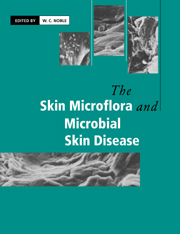Book contents
- Frontmatter
- Contents
- List of contributors
- Preface
- 1 The basis of the skin surface ecosystem
- 2 Nutrition of cutaneous resident microorganisms
- 3 Physical factors affecting the skin flora and skin disease
- 4 Coryneform bacteria
- 5 Coryneforms as pathogens
- 6 Staphylococci on the skin
- 7 Staphylococci as pathogens
- 8 Streptococci and the skin
- 9 Other cutaneous bacteria
- 10 Fungi and fungal infections of the skin
- 11 Bacterial and fungal skin disease in animals
- 12 Viral skin disease in man
- 13 Viral skin disease in animals
- 14 Microbial interactions on skin
- 15 Adherence of skin microorganisms and the development of skin flora from birth
- 16 Skin disinfection
- Index
10 - Fungi and fungal infections of the skin
Published online by Cambridge University Press: 04 December 2009
- Frontmatter
- Contents
- List of contributors
- Preface
- 1 The basis of the skin surface ecosystem
- 2 Nutrition of cutaneous resident microorganisms
- 3 Physical factors affecting the skin flora and skin disease
- 4 Coryneform bacteria
- 5 Coryneforms as pathogens
- 6 Staphylococci on the skin
- 7 Staphylococci as pathogens
- 8 Streptococci and the skin
- 9 Other cutaneous bacteria
- 10 Fungi and fungal infections of the skin
- 11 Bacterial and fungal skin disease in animals
- 12 Viral skin disease in man
- 13 Viral skin disease in animals
- 14 Microbial interactions on skin
- 15 Adherence of skin microorganisms and the development of skin flora from birth
- 16 Skin disinfection
- Index
Summary
Normal fungal flora of the skin
As with bacteria, the fungal flora on the surface of the stratum corneum of otherwise healthy persons can be regarded as consisting of two types of populations – transient and resident commensals. The resident members are the Pityrosporum (Malassezia) or lipophilic yeasts, which are found on the skin surface of all adults and cluster around the openings of sebaceous glands. The existence of a transient fungal skin flora has not been as well documented as that of the bacteria, although temporary colonization of nails and hair by dermatophytes, and of other sites by Candida spp. is recognized. Transient colonization may also reflect contamination from another site where carriage rates are comparatively higher. For example, the isolation of yeasts from the perineum may well reflect their presence in the gastrointestinal tract and, in women, in the vagina.
Malassezia (Pityrosporum) yeasts
Members of the genus Pityrosporum are thick-walled yeast fungi that inhabit the superficial layers of the stratum corneum. They comprise three main species or varieties – Pityrosporum ovale, P. orbiculare and P. pachydermatis. The first two of these are found chiefly on human hosts and P. pachydermatis on a variety of other hosts. Pityrosporum ovale and P. orbiculare are associated with certain human diseases including pityriasis versicolor, where yeasts and short, stubby hyphae can be demonstrated in skin scrapings. These hyphae were originally named, without cultural confirmation, Malassezia furfur, but are now known to represent a parastic phase of pityrosporum.
- Type
- Chapter
- Information
- The Skin Microflora and Microbial Skin Disease , pp. 232 - 263Publisher: Cambridge University PressPrint publication year: 1993
- 6
- Cited by



